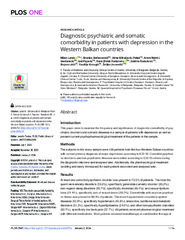Приказ основних података о документу
Diagnostic psychiatric and somatic comorbidity in patients with depression in the Western Balkan countries
| dc.creator | Latas, Milan | |
| dc.creator | Stefanovski, Branko | |
| dc.creator | Mihaljević-Peleš, Alma | |
| dc.creator | Serdarević, Amra Memić | |
| dc.creator | Pajević, Izet | |
| dc.creator | Radulović, Nera Zivlak | |
| dc.creator | Radulović, Sabina | |
| dc.creator | Đukić, Bojana | |
| dc.creator | Korugić, Vasilije | |
| dc.creator | Jovandić, Željko | |
| dc.date.accessioned | 2024-03-01T13:18:45Z | |
| dc.date.available | 2024-03-01T13:18:45Z | |
| dc.date.issued | 2024 | |
| dc.identifier.issn | 1932-6203 | |
| dc.identifier.uri | http://rimi.imi.bg.ac.rs/handle/123456789/1466 | |
| dc.description.abstract | Introduction: This paper aims to examine the frequency and significance of diagnostic comorbidity of psychiatric disorders and somatic diseases in a sample of patients with depression as well as present current psychopharmacological treatment of the patients in the sample. Methods The subjects in this study sample were 489 patients from the four Western Balkan countries with current primary diagnosis of major depression according to ICD 10. Comorbid psychiatric disorders and non-psychiatric illnesses were noted according to ICD 10 criteria during the diagnostic interview and analysed later. Additionally, the pharmacological treatment (existing and newly introduced) for each patient was noted and analysed later. Results At least one comorbid psychiatric disorder was present in 72.5% of patients. The most frequent were anxiety disorders (53.6%), specifically generalized anxiety disorder (20.2%); non-organic sleep disorders (50.7%), specifically insomnia (48.4%); and sexual dysfunctions (21.4%), specifically lack of sexual desire (20.2%). Comorbidity with any non-psychiatric illness was present in 80.3% of patients. The most frequent were circulatory system diseases (55.9%), specifically hypertension (45.9%); endocrine, nutritional and metabolic disorders (51.3%), specifically hyperlipidaemia (24.0%); and other non-psychiatric disorders (60.7%), specifically low back pain (22.7%). All patients received pharmacological treatment with different medications. Most patients received monotherapy or combination therapy of antidepressants, anxiolytics, antipsychotics and antiepileptics. The most frequently used antidepressants were escitalopram, sertraline, and duloxetine. The most frequently used anxiolytics were alprazolam and diazepam, the most used antiepileptic was pregabalin, and the most used antipsychotics were olanzapine, quetiapine, and aripiprazole. Conclusion The results of the study confirm the results of previous research studies about the high prevalence of psychiatric and non-psychiatric comorbidities in patients with depression that were conducted in the past. It would be important if future studies could prove the importance of those comorbidities on clinical severity, choice of treatment, and its outcome in patients with depression. | |
| dc.language | en | |
| dc.publisher | PLOS | |
| dc.rights | openAccess | |
| dc.rights.uri | https://creativecommons.org/licenses/by/4.0/ | |
| dc.source | PLOS ONE | |
| dc.title | Diagnostic psychiatric and somatic comorbidity in patients with depression in the Western Balkan countries | |
| dc.type | article | en |
| dc.rights.license | BY | |
| dc.citation.issue | 1 | |
| dc.citation.spage | e0295754 | |
| dc.citation.volume | 19 | |
| dc.identifier.doi | 10.1371/journal.pone.0295754 | |
| dc.identifier.fulltext | http://rimi.imi.bg.ac.rs/bitstream/id/3460/Diagnostic_psychiatric_and_somatic_comorbidity_2024.pdf | |
| dc.type.version | publishedVersion |

